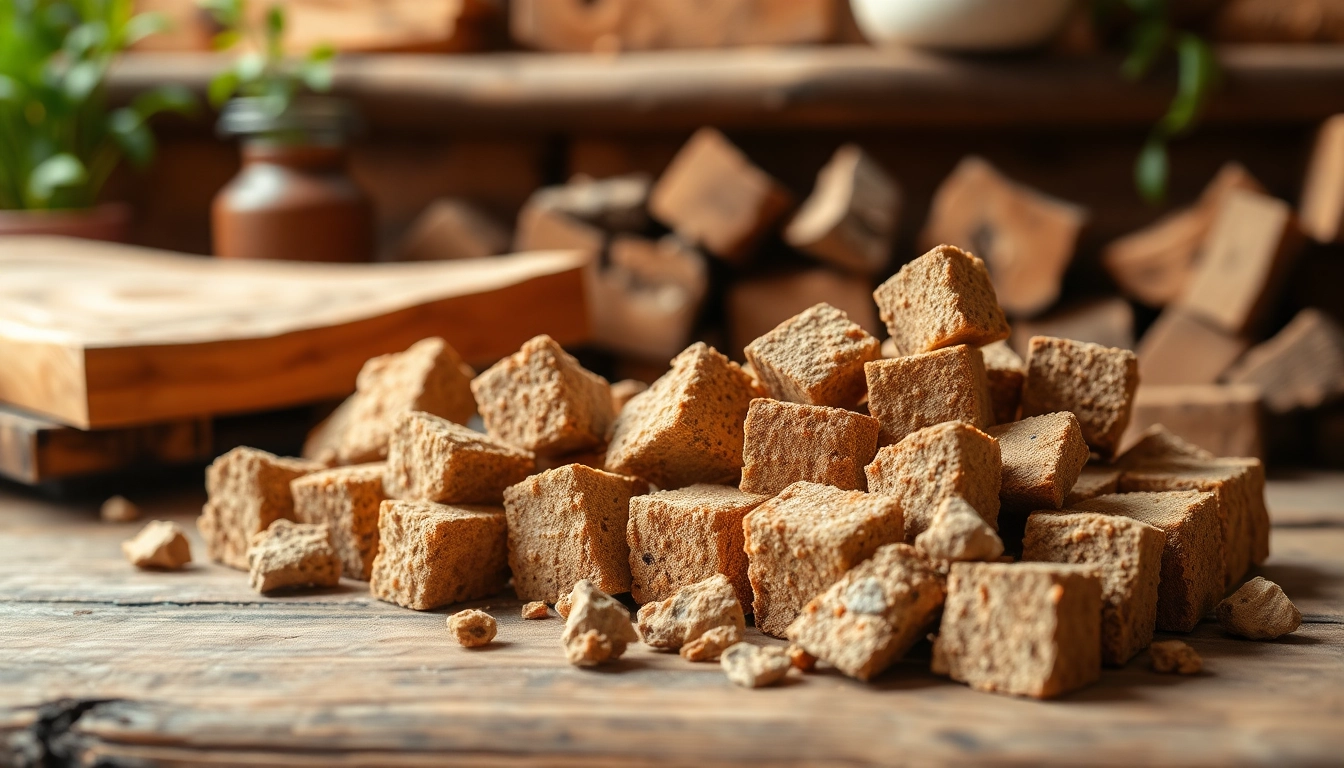Understanding Briquettes: What Are They?
Briquettes are a versatile and efficient form of fuel, often used for heating, cooking, and various other applications. They are engineered from a variety of biomass materials, which are compacted and carbonized under high pressure. The result is a product that is denser and produces less ash than traditional fuels, making it a preferred choice for those looking to enhance their energy efficiency. One of the major advantages of using Briquettes is their ability to provide a consistent burn rate, which is crucial for both cooking and heating purposes.
The Composition of Briquettes
The composition of briquettes can vary significantly based on the materials used and the manufacturing process. Generally, they are composed primarily of organic materials such as wood chips, sawdust, agricultural residues, and other similar biomass products. The best-quality briquettes often contain a higher percentage of hardwood, which yields a better heat output and longer burn time. Importantly, additives like starch may be included to help bind the materials together without the use of harmful chemicals. This not only makes briquettes a cleaner-burning fuel but also contributes to their eco-friendliness.
Types of Briquettes Available
There are several types of briquettes on the market, each designed to cater to different needs and applications:
- Wood Briquettes: Made primarily from wood materials, these are the most common type. They offer high heat output and are ideal for heating and cooking.
- Charcoal Briquettes: Often used for outdoor grilling, these briquettes provide a steady burn and characteristic smoky flavor, making them a favorite among barbecue enthusiasts.
- Biomass Briquettes: Created from agricultural waste like rice husks or coconut shells, these briquettes are gaining popularity due to their lower carbon footprint.
- Sawdust Briquettes: Produced from compressed sawdust, these briquettes are often used in fireplaces and wood burners because of their low moisture content and high calorific value.
The Benefits of Using Briquettes
The use of briquettes offers many benefits over traditional firewood and other fuel sources:
- Efficient Energy Output: Briquettes produce more energy per unit weight than traditional logs, making them more efficient.
- Consistent Burn: They provide a steady and controllable burn rate, enhancing the efficiency of heating and cooking activities.
- Low Ash Production: The combustion of briquettes results in minimal ash, making cleanup easier.
- Environmental Benefits: Many briquettes are made from recycled materials and result in fewer emissions than traditional fuels.
- Cost-Effective: In many regions, briquettes can be more affordable than firewood, especially when considering their higher efficiency.
How Briquettes Compare to Traditional Fuels
As consumers become more eco-conscious and energy-efficient, understanding how briquettes stack up against traditional fuels such as firewood and coal is essential.
Efficiency and Burn Rate of Briquettes
When comparing briquettes to traditional firewood, one can discern that briquettes offer a higher calorific value, meaning they generate more heat per kilogram burned. For instance, they typically burn for a longer period and produce a more stable heat output, making them advantageous in situations where consistent temperatures are critical, such as in cooking. The moisture content of briquettes is generally lower than that of firewood, which also leads to better combustion efficiency.
Environmental Impact of Briquettes
While traditional fuels contribute to deforestation and higher carbon emissions, briquettes can be produced from waste materials, thus promoting recycling and sustainability. Many briquettes are designed to produce significantly lower emissions and particulate matter when burned, contributing positively to air quality. This eco-friendliness makes briquettes a compelling option for those looking to reduce their environmental footprint.
Cost Comparison: Briquettes vs. Logs
Comparing the cost of briquettes to that of traditional firewood reveals varying outcomes based on local availability and market prices. In many cases, briquettes can be more cost-effective due to their higher energy content. They often require less fuel to achieve the same heating result, which can lead to savings over time. Users should consider factors such as heating needs, local fuel prices, and availability before deciding which option to pursue.
Best Practices for Using Briquettes
To maximize the benefits and efficiency of briquettes, users should adhere to best practices when utilizing them for heating and cooking.
Storing Briquettes Properly
Proper storage of briquettes is essential to maintain their integrity and performance. Because briquettes can absorb moisture, it is important to keep them in a dry, well-ventilated area. Ideally, they should be stored on pallets and covered with a waterproof tarpaulin if exposed to outdoor conditions. This helps prevent degradation and ensures a longer shelf life.
Optimal Cooking Techniques with Briquettes
When using briquettes for cooking, particularly in barbecuing or grilling, it is important to let them ash over before starting to cook. This ensures that they burn evenly. Additionally, creating a two-zone fire can enhance cooking versatility; one side can be for direct heat while the other can be cooler, allowing for indirect cooking. Furthermore, monitoring the airflow and adjusting vents on a grill or smoker can help control the heat and improve cooking outcomes.
Maintenance Tips for Briquette Users
To get the most out of briquettes, users should regularly maintain their heating equipment. This includes cleaning ash buildup frequently, checking for any blockages in the airflow, and ensuring that seals are tight to prevent heat loss. Regular inspections not only enhance performance but contribute to safety by preventing any potential hazards associated with improper maintenance.
Innovative Uses for Briquettes Beyond Heating
While briquettes are largely recognized for their heating capabilities, they can also be utilized in creative ways that extend beyond conventional applications.
Using Briquettes for Outdoor Grilling
Briquettes are particularly popular among outdoor cooking enthusiasts since they provide a reliable source of heat. When used in grills or smokers, briquettes can be arranged strategically to create zones of varying temperatures, allowing for diverse cooking methods like searing, roasting, or smoking. Additionally, choosing flavored briquettes can add unique tastes and aromas to grilled dishes, enhancing the culinary experience.
Natural Pest Repellent Properties of Briquettes
Another innovative use for briquettes involves their potential as a natural pest repellent. When burned, some types of briquettes can produce smoke with constituents that deter bugs. This makes them an eco-friendly option for outdoor gatherings, where having a pest-free environment is often a priority.
Creative DIY Projects with Briquettes
Briquettes can also be repurposed for various DIY projects. For instance, they can be used as planters due to their natural composition, which can provide nutrients for plants. Furthermore, creative individuals have used leftover briquettes to craft unique garden designs or artistic installations, tapping into their aesthetic qualities while being environmentally conscious.
Evaluating the Performance of Briquettes
Before committing to a specific type of briquette, it is important for consumers to evaluate their performance based on several criteria.
How to Measure Burn Efficiency
Burn efficiency can be measured by assessing the time taken for briquettes to ignite, their burn duration, and the amount of heat output generated during combustion. Consumers can also measure how long a known weight of briquettes lasts and how much heat it produces, which allows for a comparative analysis against other fuel types.
Monitoring Ash Production and Cleanup
The amount of ash produced after burning briquettes is another vital indicator of their quality. Low-ash briquettes tend to signify a higher-quality product. Consumers should consider how often they need to clean their grates and surfaces, as excessive ash can hinder efficient combustion and require more maintenance.
Customer Reviews and Feedback on Briquettes
Lastly, reading customer reviews and feedback can provide insights into the performance and suitability of different briquettes. Users often share their experiences regarding heat output, taste of food when used for grilling, and overall satisfaction. This information can be pivotal for potential buyers in selecting the right product for their specific needs.




